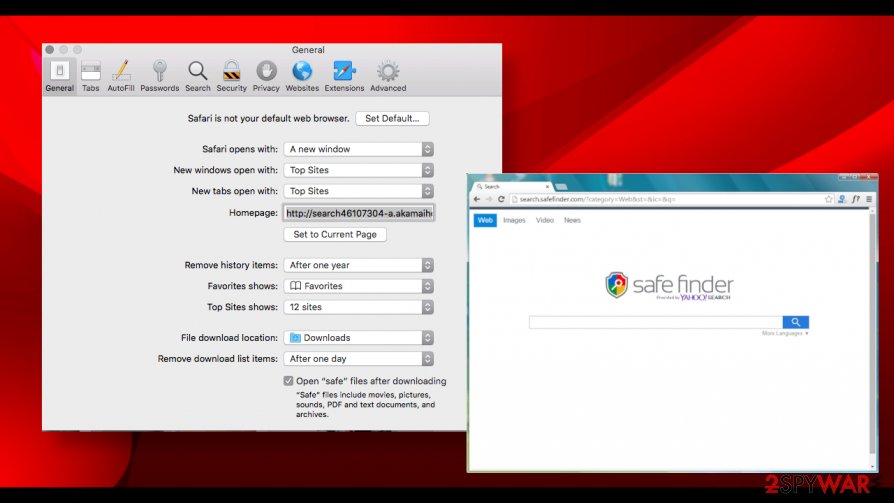EngageSearch (Virus Removal Instructions) - Improved Instructions
EngageSearch Removal Guide
What is EngageSearch?
EngageSearch is an intrusive Mac adware that may settle down on Safari and Chrome to promote affiliate websites

EngageSearch is a free browser add-on oriented to MacOS running machines. Although it can be downloaded from the official website, most of the users get it installed unintentionally when downloading free software from unverified sources. Due to the misleading distribution and controversial performance, this application has been classified as Mac adware and Potentially Unwanted Application (PUA) that has certain browser-hijacking[1] traits.
Although the EngageSearch engine is represented in a rather professional manner, experts do not recommend installing it as it's not going to provide useful services. Instead, it's likely to hijack Safari and Google Chrome (other web browsers might also be affected) and, subsequently, initiate web browser redirects via akamaihd.com and promote Safe Finder search. Apart from that, users can also start receiving loads of catchy ads most of which correspond to the users' browsing history. Thus, if you see this app installed, employ a robust Mac anti-malware and remove EngageSearch virus from the system without a delay.
| Name | EngageSearch |
| Type of malware | Adware with come browser hijacking traits |
| Sub-type | Potentially Unwanted Program (PUP) |
| Symptoms | Web browser's slowdowns Altered web browser's settings (start page, search engine, new tab window, etc.) Common redirects via akamaihd.com website Safe Finder search engine set as a default No way for getting Google, Bing or other search results Intrusive ads generated on random websites |
| Compatibility | macOS adapted software |
| Distribution | The direct download can be found on some unreputable download websites. However, the biggest risk of accidental malware download is related to the reckless freeware[2] installation process. |
| Removal | ]Adware removal is not a difficult task to accomplish. However, it's recommended to use an anti-malware tool to get rid of it because a bunch of other PUPs might have been installed alongside. Those who opt for eliminating it manually can rely on a step-by-step tutorial that is given below. |
| Fix the damage | Post-malware system treatment requires an in-depth scan with a professional repair tool. We recommend using FortectIntego |
EngageSearch virus is a term that is most frequently used to describe this Mac app. Such classification has several reasons:
- The app usually gets installed behind the user's back (disguised under freeware installation setup);
- Upon installation, it triggers havoc within the web browser, i.e. altered settings, inability to access Google;
- Intrusive ads, pop-ups, banners, interstitial ads, and other forms of advertising content on random websites emerge;
- Web browser slows down and frequently freezes;
- Web browser's cookies, web beacons, and similar tracking software might be installed to harvest peoples' web browsing history, etc.
- Ongoing redirects to the akamaihd-related websites disrupt web browsing activities, etc.
The main symptoms of the EngageSearch Mac adware to be installed on the machine manifest within the web browser. The app may install some web browser's add-ons, extensions, set Safe Finder as a default start page (does not allow replacing it), and enables some Push Notifications.
Apart from the mentioned changes, the EngageSearch virus displays altered search results, which contain links to affiliated domains. The same applies to the advertising content that the user may receive. Despite the fact that the ads may be eye-catching, the may contain irrelevant links, which once clicked may expose you to suspicious or even malware-laden websites.
As we have also mentioned, the EngageSearch removal should not be questioned because the app may also be involved in data-tracking, storing, and sharing activities. Thus, to prevent ongoing leakage of the search queries, mostly visited websites, IP address, geolocation, etc. get rid of the adware asap.
In order to remove EngageSearch Mac virus easily, we recommend using a professional anti-malware utility. It will ensure an in-depth system scan and a proper malware elimination process. After that, ensure virus damage fix using FortectIntego tool.

Misleading ads on shady sites and freeware bundles should be treated carefully
The Internet is a huge advertising platform. That's an undeniable fact. However, some advertisements are well-prepared by reliable marketing managers and offer reliable, usually useful, services, products, software, or whatnot. Unfortunately, affiliate marketing can sometimes be misleading and trick into downloading malware.
To protect yourself from seeing commercial content when web browsing, it's very important to keep the machine adware and browser hijacker-free. This type of malware is not dangerous; however, they can be misused for initiating misleading advertising schemes.
Third-party ad-supported applications are distributed via misleading click-bait ads or freeware bundles. Thus, if clicking on a random website ends up with a download of some suspicious .exe file, do not open the file because it may be a suspicious extension, namely adware.
In addition, be very cautious when downloading freeware and shareware. Opt for the Advanced/Custom installation option all the time and monitor the entire process carefully. If you notice some statements saying that you agree with the installation of browser-based apps or any other components, reject their installation by removing the checkmarks.

Learn how to eliminate EngageSearch ads and stop intrusive redirects
Although adware and other browser-based malware does not affect the system directly, experts from Virusai.lt[3] recommend people to employ a proper system cleaning tool to remove EngageSearch virus and all associated files. It is possible to restore all affected processes and system performance by changing certain settings and cleaning up the web browser.
EngageSearch removal is a process that requires paying close attention to details and relying on a professional application that could automatically check the machine and delete all potentially unwanted programs completely. Manual removal cannot ensure a complete system cleaning, so it's always best to have a professional anti-malware and scan the system regularly.
Besides, a manual EngageSearch removal also poses a risk of leaving active malware components that may interfere with the normal system's performance. Thus, if you decide to eliminate the malware manually, take proper care to fix the libraries and ensure that the system has been properly restored to the state before the malware attack. This can be done with a tool, such as FortectIntego.
You may remove virus damage with a help of FortectIntego. SpyHunter 5Combo Cleaner and Malwarebytes are recommended to detect potentially unwanted programs and viruses with all their files and registry entries that are related to them.
Getting rid of EngageSearch. Follow these steps
Uninstall from Windows
Instructions for Windows 10/8 machines:
- Enter Control Panel into Windows search box and hit Enter or click on the search result.
- Under Programs, select Uninstall a program.

- From the list, find the entry of the suspicious program.
- Right-click on the application and select Uninstall.
- If User Account Control shows up, click Yes.
- Wait till uninstallation process is complete and click OK.

If you are Windows 7/XP user, proceed with the following instructions:
- Click on Windows Start > Control Panel located on the right pane (if you are Windows XP user, click on Add/Remove Programs).
- In Control Panel, select Programs > Uninstall a program.

- Pick the unwanted application by clicking on it once.
- At the top, click Uninstall/Change.
- In the confirmation prompt, pick Yes.
- Click OK once the removal process is finished.
Delete from macOS
EngageSearch adware targets MacOS in particular. If you have accidentally installed it on your machine, follow this tutorial to get rid of it completely.
Remove items from Applications folder:
- From the menu bar, select Go > Applications.
- In the Applications folder, look for all related entries.
- Click on the app and drag it to Trash (or right-click and pick Move to Trash)

To fully remove an unwanted app, you need to access Application Support, LaunchAgents, and LaunchDaemons folders and delete relevant files:
- Select Go > Go to Folder.
- Enter /Library/Application Support and click Go or press Enter.
- In the Application Support folder, look for any dubious entries and then delete them.
- Now enter /Library/LaunchAgents and /Library/LaunchDaemons folders the same way and terminate all the related .plist files.

Remove from Microsoft Edge
Delete unwanted extensions from MS Edge:
- Select Menu (three horizontal dots at the top-right of the browser window) and pick Extensions.
- From the list, pick the extension and click on the Gear icon.
- Click on Uninstall at the bottom.

Clear cookies and other browser data:
- Click on the Menu (three horizontal dots at the top-right of the browser window) and select Privacy & security.
- Under Clear browsing data, pick Choose what to clear.
- Select everything (apart from passwords, although you might want to include Media licenses as well, if applicable) and click on Clear.

Restore new tab and homepage settings:
- Click the menu icon and choose Settings.
- Then find On startup section.
- Click Disable if you found any suspicious domain.
Reset MS Edge if the above steps did not work:
- Press on Ctrl + Shift + Esc to open Task Manager.
- Click on More details arrow at the bottom of the window.
- Select Details tab.
- Now scroll down and locate every entry with Microsoft Edge name in it. Right-click on each of them and select End Task to stop MS Edge from running.

If this solution failed to help you, you need to use an advanced Edge reset method. Note that you need to backup your data before proceeding.
- Find the following folder on your computer: C:\\Users\\%username%\\AppData\\Local\\Packages\\Microsoft.MicrosoftEdge_8wekyb3d8bbwe.
- Press Ctrl + A on your keyboard to select all folders.
- Right-click on them and pick Delete

- Now right-click on the Start button and pick Windows PowerShell (Admin).
- When the new window opens, copy and paste the following command, and then press Enter:
Get-AppXPackage -AllUsers -Name Microsoft.MicrosoftEdge | Foreach {Add-AppxPackage -DisableDevelopmentMode -Register “$($_.InstallLocation)\\AppXManifest.xml” -Verbose

Instructions for Chromium-based Edge
Delete extensions from MS Edge (Chromium):
- Open Edge and click select Settings > Extensions.
- Delete unwanted extensions by clicking Remove.

Clear cache and site data:
- Click on Menu and go to Settings.
- Select Privacy, search and services.
- Under Clear browsing data, pick Choose what to clear.
- Under Time range, pick All time.
- Select Clear now.

Reset Chromium-based MS Edge:
- Click on Menu and select Settings.
- On the left side, pick Reset settings.
- Select Restore settings to their default values.
- Confirm with Reset.

Remove from Mozilla Firefox (FF)
In case Mozilla Firefox ads keep interrupting your web browsing activities, you need to restore the web browser's settings after complete malware removal.
Remove dangerous extensions:
- Open Mozilla Firefox browser and click on the Menu (three horizontal lines at the top-right of the window).
- Select Add-ons.
- In here, select unwanted plugin and click Remove.

Reset the homepage:
- Click three horizontal lines at the top right corner to open the menu.
- Choose Options.
- Under Home options, enter your preferred site that will open every time you newly open the Mozilla Firefox.
Clear cookies and site data:
- Click Menu and pick Settings.
- Go to Privacy & Security section.
- Scroll down to locate Cookies and Site Data.
- Click on Clear Data…
- Select Cookies and Site Data, as well as Cached Web Content and press Clear.

Reset Mozilla Firefox
If clearing the browser as explained above did not help, reset Mozilla Firefox:
- Open Mozilla Firefox browser and click the Menu.
- Go to Help and then choose Troubleshooting Information.

- Under Give Firefox a tune up section, click on Refresh Firefox…
- Once the pop-up shows up, confirm the action by pressing on Refresh Firefox.

Remove from Google Chrome
Uninstall EngageSearch extension from Chrome using this guide:
Delete malicious extensions from Google Chrome:
- Open Google Chrome, click on the Menu (three vertical dots at the top-right corner) and select More tools > Extensions.
- In the newly opened window, you will see all the installed extensions. Uninstall all the suspicious plugins that might be related to the unwanted program by clicking Remove.

Clear cache and web data from Chrome:
- Click on Menu and pick Settings.
- Under Privacy and security, select Clear browsing data.
- Select Browsing history, Cookies and other site data, as well as Cached images and files.
- Click Clear data.

Change your homepage:
- Click menu and choose Settings.
- Look for a suspicious site in the On startup section.
- Click on Open a specific or set of pages and click on three dots to find the Remove option.
Reset Google Chrome:
If the previous methods did not help you, reset Google Chrome to eliminate all the unwanted components:
- Click on Menu and select Settings.
- In the Settings, scroll down and click Advanced.
- Scroll down and locate Reset and clean up section.
- Now click Restore settings to their original defaults.
- Confirm with Reset settings.

Delete from Safari
Safari is by far the most widely used web browser on macOS machines. Its settings can be altered if the user gets tricked into installing a freeware bundle. To eliminate unwanted extensions from Safari, try using this guide.
Remove unwanted extensions from Safari:
- Click Safari > Preferences…
- In the new window, pick Extensions.
- Select the unwanted extension and select Uninstall.

Clear cookies and other website data from Safari:
- Click Safari > Clear History…
- From the drop-down menu under Clear, pick all history.
- Confirm with Clear History.

Reset Safari if the above-mentioned steps did not help you:
- Click Safari > Preferences…
- Go to Advanced tab.
- Tick the Show Develop menu in menu bar.
- From the menu bar, click Develop, and then select Empty Caches.

After uninstalling this potentially unwanted program (PUP) and fixing each of your web browsers, we recommend you to scan your PC system with a reputable anti-spyware. This will help you to get rid of EngageSearch registry traces and will also identify related parasites or possible malware infections on your computer. For that you can use our top-rated malware remover: FortectIntego, SpyHunter 5Combo Cleaner or Malwarebytes.
How to prevent from getting adware
Protect your privacy – employ a VPN
There are several ways how to make your online time more private – you can access an incognito tab. However, there is no secret that even in this mode, you are tracked for advertising purposes. There is a way to add an extra layer of protection and create a completely anonymous web browsing practice with the help of Private Internet Access VPN. This software reroutes traffic through different servers, thus leaving your IP address and geolocation in disguise. Besides, it is based on a strict no-log policy, meaning that no data will be recorded, leaked, and available for both first and third parties. The combination of a secure web browser and Private Internet Access VPN will let you browse the Internet without a feeling of being spied or targeted by criminals.
No backups? No problem. Use a data recovery tool
If you wonder how data loss can occur, you should not look any further for answers – human errors, malware attacks, hardware failures, power cuts, natural disasters, or even simple negligence. In some cases, lost files are extremely important, and many straight out panic when such an unfortunate course of events happen. Due to this, you should always ensure that you prepare proper data backups on a regular basis.
If you were caught by surprise and did not have any backups to restore your files from, not everything is lost. Data Recovery Pro is one of the leading file recovery solutions you can find on the market – it is likely to restore even lost emails or data located on an external device.
- ^ What Is Browser Hijacking?. Kaspersky. Cybersecurity experts and software developers.
- ^ Liam Tung. Google: Unwanted bundled software is way more aggressive than malware. ZDnet. Business security news.
- ^ SAUGUMO IR VIRUSŲ NAUJIENOS. Virusai. Virus and spyware news.
